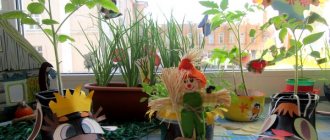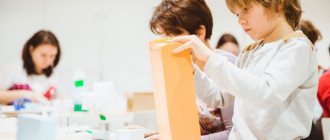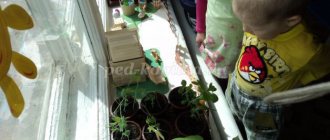Summary of the lesson “Vegetable garden on the windowsill” in the first junior group
Anastasia Toropova
Summary of the lesson “Vegetable garden on the windowsill” in the first junior group
Maslenitsa week has passed, we spent the winter and are looking forward to spring. I already want to see primroses , leaves on the trees and the first greenery in the gardens . Of course, the primroses and leaves are still about a month away, but we can see the greenery in the garden . How can you ask? We bring to your attention a vegetable garden on the windowsill .
A vegetable garden in kindergarten promotes the development of curiosity and observation in children, and this helps to better understand plant life. He is able to expand children's ideas about plants as living organisms, about the conditions necessary for growth and development, develop aesthetic feelings, the ability to enjoy the beauty of grown plants and the results of their work. And how much joy the first plantings and shoots .
of the first junior group of MBDOU d/s No. 24 planted their first “ Garden on the windowsill . The garden turned out bright and colorful.
The children learned the steps of planting onions, garlic and peas and are now looking forward to the first shoots , of course, not forgetting to water their plantings.
group's teachers set a goal to expand children's understanding of how to care for plants indoors, to introduce them to the need for light, heat, moisture, and soil for plant growth. Develop the cognitive and creative abilities of children at a young age .
Very soon the first shoots , the guys will definitely taste the greens they planted and grew with their own hands.
Photo report “Vegetable garden on the windowsill” in the kindergarten group “Vegetable garden on the windowsill” in the kindergarten group The influence of the surrounding world on the development of a child is enormous. Getting to know the endless, constantly.
Summary of a lesson on speech development in the first junior group "Granny's garden" Summary of a lesson on speech development in the first junior group Topic: "Grandma's garden" Educator: Karmeeva L.V. Purpose: To consolidate concepts.
Summary of a lesson on the sensory development of children of the first junior group “We have a vegetable garden” Summary of a lesson on the sensory development of children of the first junior group “We have a vegetable garden.” Goal: To form elementary ideas in children.
Vegetable garden on the windowsill “Not a vegetable garden, but a fairy tale” “People are noisy at the gate. Where is the winter garden? They say it grows there. Cucumber seedlings. And dill and onion. Everyone looks at the garden and leaves.
Project for children of the second junior group “Vegetable garden on the windowsill” Project “Vegetable garden on the windowsill” Prepared by: Gridchina I. G. April - May 2022 Term: short-term (7 weeks) Type: educational.
Environmental project in the senior group “Vegetable garden on the windowsill” Municipal budgetary preschool educational institution “Uzhur kindergarten No. 1” Environmental project “Vegetable garden on the windowsill”.
Project in the early development group “Vegetable garden on the windowsill” Project in the early development group “Vegetable garden on the windowsill” Educators: Kotlyarova T. P. Filipenko O. V. 2022 Project goal: Decoration. Vegetable garden on the windowsill using the origami technique “Fun Vegetable Garden” Cheerful Vegetable Garden In the spring of 2022, the children of the middle group, as well as the junior group, and I worked in two groups on a schedule (three shifts each.
Excursion to the vegetable garden in the first junior group Purpose: 1. Give children an idea of vegetables; about the work of adults in the garden. 2. Activate children's vocabulary with words: vegetables, garden, carrots.
Source
CHILDHOOD GUIDE
Ecological project
"Garden on the window"
for young children
Mosienko Elena Yurievna,
teacher of MKDOU No. 16,
Novosibirsk city
- Project abstract
Project type: educational.
Type of project: research.
Project participants: children of the nursery group, group teacher, parents.
Social significance of the project: involving children in the work of growing greenery on the windowsill together with an adult in the winter, developing determination, observation, and nurturing interest in the world of plants.
The goal of the project: to develop in children the need to care for garden crops and the ability to observe their growth. Involving parents in joint research activities.
Project implementation:
The project is being implemented in three stages - preparatory, main, final.
Main project activities:
- A series of educational lessons (basic scientific information) on the study of cultivated and ornamental plants.
- Research and practical activities of children to study the characteristics of growing garden and ornamental crops.
- Presentation of the project “Vegetable garden on the window”.
Project duration: 3 months.
Further development of the project: the project organization is planned in subsequent age groups with the planting of new garden crops.
- Justification of the social significance of the project
Relevance of the project: Many parents who have their own gardens (dachas) do not suspect that the green kingdom will begin to arouse the child’s great interest if adults teach them to observe the plant, to see in the green sprout a special living creature, whose life depends entirely on whether it receives care or not. Only with the help of adults can a preschooler understand that the life of a plant depends on the presence of heat, light and good soil, and learn to distinguish a healthy and strong plant from a weak, frail one that requires “treatment.” Having learned to understand the state of plants, the child will sympathize and care for them. Thus, the tasks of cognitive-research, social-personal, and aesthetic development of the child are solved. Young children love to act. They understand the world around them practically, and their actions by observing the results. Practical activity is the direct participation of children in caring for plants. Introduction to feasible work caring for plants is, first of all, the development of such qualities as responsibility for completing an assignment, for the result obtained, commitment, and determination. And these are very important qualities for a child’s education at school. However, the problem is that children of early and early preschool age do not have sufficient understanding of plants, where they grow, the necessary conditions for their growth, and their interest in cognitive and research activities is not sufficiently developed. To satisfy children's curiosity and instill the first skills of activity and independent thinking, we have created conditions for children's search and research activities. Familiarization with the growth and development of plants can be done in the winter-spring period by growing various crops from seeds and bulbs in the kindergarten premises, using a vegetable garden on the window.
- The goal of the project: to develop in children the need to care for garden crops and the ability to observe their growth. Involving parents in joint research activities.
Project objectives:
- To develop children's knowledge about the growth and needs of plants.
- To develop the ability to observe and care for garden crops.
- To develop the ability to formalize the results of observations (calendar of cultural life).
- Develop curiosity, interest in research and experimentation.
- Foster a caring and caring attitude towards plants.
- Form partnerships between teachers, children and parents.
- Project methodology. Main stages and directions of implementation of the project goal:
Preparatory stage.
Activities of the teacher:
- Conversations with children (identifying the level of knowledge about plants).
- Drawing up a work plan for the project.
- Collection of material necessary for the implementation of the project.
- Development of lesson notes and presentations on the planned topic.
- Organization of a subject-development environment on the topic of the project.
- Production of didactic games and manuals.
Children's activities:
- Review of illustrative material on the topic of the project.
Interaction with family:
- Collecting the necessary material to create a vegetable garden.
- Joint discussion of activities to implement the project.
Practical work.
Activities of the teacher:
- Conversation with children of an educational nature.
- Organization of a subject-development environment on the topic.
- Preparation of information for parent corners.
- Organization of competitions, entertainment, exhibitions.
- Creating presentations for classes on the topics: “At Luka and Lukerya”, “The World of Plants”, “Riddles about Vegetables”.
Children's activities:
- Planting seeds in the ground.
- Plant care.
- Completing tasks in independent observations.
- Preparation of attributes and costumes for entertainment.
- Playful and motor activities.
- Participation in practical activities.
Joint activities between adults and children:
- Teacher's stories, reading children's fiction.
- Various types of visual activities on environmental themes.
- Working with an observation diary.
- Watching films about plants.
- Collecting seed collections.
- Examination of didactic pictures, illustrations about vegetables and herbs.
- Work in the garden.
Summarizing.
Activities of the teacher:
- Final conversation with children (analysis of the work done).
- Project presentation.
- Representation of experience.
Children's activities:
- Participation in the final discussion about the work done.
- Participation in the presentation of the project “Vegetable garden on the window”
Sharing experience.
- Familiarization of preschool teachers with successfully completed work.
- Design of albums, booklets, photo exhibitions for parents.
Project implementation activities
- Conversations:
- “What is a “Vegetable Garden on a Window”?
- "At Luke and Lukerya"
- "Plants are life"
- "Seeds"
- “Sun, air and water are our best friends.”
- Experimental activities:
- "Structure of plants"
- "Growth and Development of Plants"
- “Earth, what is it like?”
- "Water and Sprout"
- "Sun and Sprout"
- "Growing Seeds"
- Practical activities and work assignments:
- Selection and sowing of seeds.
- Watering, caring for and observing vegetable crops in the “garden”.
- Ecological classes on the topics: “The Magic Basket”, “The World of Vegetables”, “Seeds”, “First Shoots”.
- Game activity:
- Didactic games: “Tops and Roots”, “Wonderful Bag”.
- Board game “Paired pictures”, “Vegetables”.
- Looking at illustrations depicting various plants that can be grown on a windowsill.
- Looking at different seeds.
- Artistic and creative activities of children.
- Coloring pictures “I grow in the garden.”
- Making signboards with the names of plants and the first sunrises.
- Drawing “Onion cures all ailments.”
- Modeling "Vegetables large and small."
- Application “Zaikin’s garden”, “Pod”.
- Speech and verbal communication.
- Reading fairy tales: “Turnip”, “Tops and Roots”, “Puff”.
- Dramatization - the game “Once upon a time a housewife came from the market.”
- Children's story on the topic: "Grandmother's dacha garden."
- Learning poems, riddles, proverbs and sayings about vegetables with children.
- Filling out an observation diary.
- Album design “Our first vegetable garden.”
- Consultation for parents “Teaching your child to help.”
Resource support.
- A selection of methodological and fiction literature and illustrations.
- Ecological corner.
- Methodological tools: lesson notes, entertainment scenarios, card index of didactic games, etc.
- Technical means: computer, stereo system, camera, etc.
Estimated distribution of roles in the project team:
Educator: selects the necessary material, organizes educational situations (planting crops), effectively develops the creative and cognitive thinking of preschool children, and attracts parents of students to replenish the group’s developmental environment and knowledge of preschoolers.
Children: participate in educational activities, observe the germination of garden crops.
Parents: purchased land, seeds, material for planting care, organized a development environment for effective placement in the group.
Risks: Illness of children, teachers, lack of material resources, natural disasters and other unforeseen circumstances.
- Project implementation work plan
Project implementation stages
1) Preparatory (implementation period – February).
2) Main (implementation period - February, March, April).
- soil preparation, purchasing seeds, planting, watering, loosening;
- decorating a vegetable garden on a window;
- Observation of plants and experiments, followed by examination and recording of drawings and diagrams.
- Reflection of the result through artistic and creative activity.
3) Final (implementation period – April).
- Expected results, mechanism for monitoring and evaluating project results
Expected results: A plant can be grown from a seed, bulb, or grain. By creating a garden on the window, we will grow onions, peas, tomatoes, cucumbers and other vegetables. Children will develop an interest in plants. They will be able to distinguish between certain types of plants, learn a lot of interesting things about the life of plants, and experimentally study the conditions necessary for their growth. Children will learn to make observations and make the first conclusions. Practical activity is the direct participation of children in caring for plants. Introduction to feasible work caring for plants is, first of all, the development of such qualities as responsibility for completing an assignment, for the result obtained, commitment, and determination. To understand the results of our practical work, we conducted a diagnostic to study interest in research and practical activities to study the characteristics of growing plants in the “garden on the window”. A diagnostic study was carried out twice: at the beginning and at the end of the project with the entire group of children participating in the project. We entered the results of observations and conversations with children on the main indicators and diagnostic criteria into a table. We assessed the quality of the main indicators at three levels: high, medium, low. The average quality result was taken as the final level. The results obtained were processed and calculated as a percentage.
Table
| FULL NAME. | Shows interest in plant crops | Knows and names several vegetable crops | Distinguishes and names the structure of vegetable crops | Knows plant growth conditions | Bottom line | ||||
| At the beginning of the project | At the end of the project | At the beginning of the project | At the end of the project | At the beginning of the project | At the end of the project | At the beginning of the project | At the end of the project | ||
| 1. | |||||||||
| 2. | |||||||||
| 3. | |||||||||
High level: The child shows interest in research activities in the knowledge of the plant world. Recognizes and names 2-3 plants and their main parts. Can compare plants, find similarities and differences in external characteristics. Knows the conditions of plant growth and establishes a connection between the plant and its needs for light, heat, and moisture. Actively demonstrates a desire to participate in plant care.
Intermediate level: The child is unstable in showing interest in plants. Experiences difficulty in determining the names of plants, and also finds it difficult to identify parts of plants. He does not independently establish connections between plants and his needs. Participates in caring for plants, but does not show much desire.
Low level: The child does not know the names of plants. Has no interest in plants. Ideas about the structural features of plants and the conditions for their growth are unstable. There is no desire to care for plants.
The results of repeated diagnostics, as we expected, were higher on average by 21%, which allowed us to conclude that the level of interest of children of the second junior group in research activities in the knowledge of the plant world has increased significantly. Children began to distinguish plants, became acquainted with the conditions of their growth, learned to care for plants and even teach and explain to their parents how to do it correctly.
- Prospects for further development of the project
Our project confirmed that in the future it is necessary to promote the merging of the child with the nature of his native land, to form an aesthetic attitude towards it, to deepen knowledge, improve skills, and support the individuality of each child. And then the child will show interest in research and cognitive activities, and will independently and creatively master new methods of research for a more accurate result.
In the future, we plan to carry out this project in subsequent age groups, since during the project, children’s ideas about plants as living organisms, about the conditions necessary for growth and development have expanded, an aesthetic sense has developed, and the ability to enjoy the beauty of grown plants and the result of their work.
Children learned to observe, began to treat the plant world more carefully, and interact correctly with plants according to the “do no harm” principle. All project participants (children, teachers, parents) received positive emotions from the results obtained. The experience we have gained will be distributed among teachers of preschool educational institutions. The development of the project and updating of the material and technical base is expected through the attraction of extra-budgetary funds, parental and sponsorship assistance. Vegetable garden on the window My favorite toys The wonderful world of postcards My flower on planet Earth >







